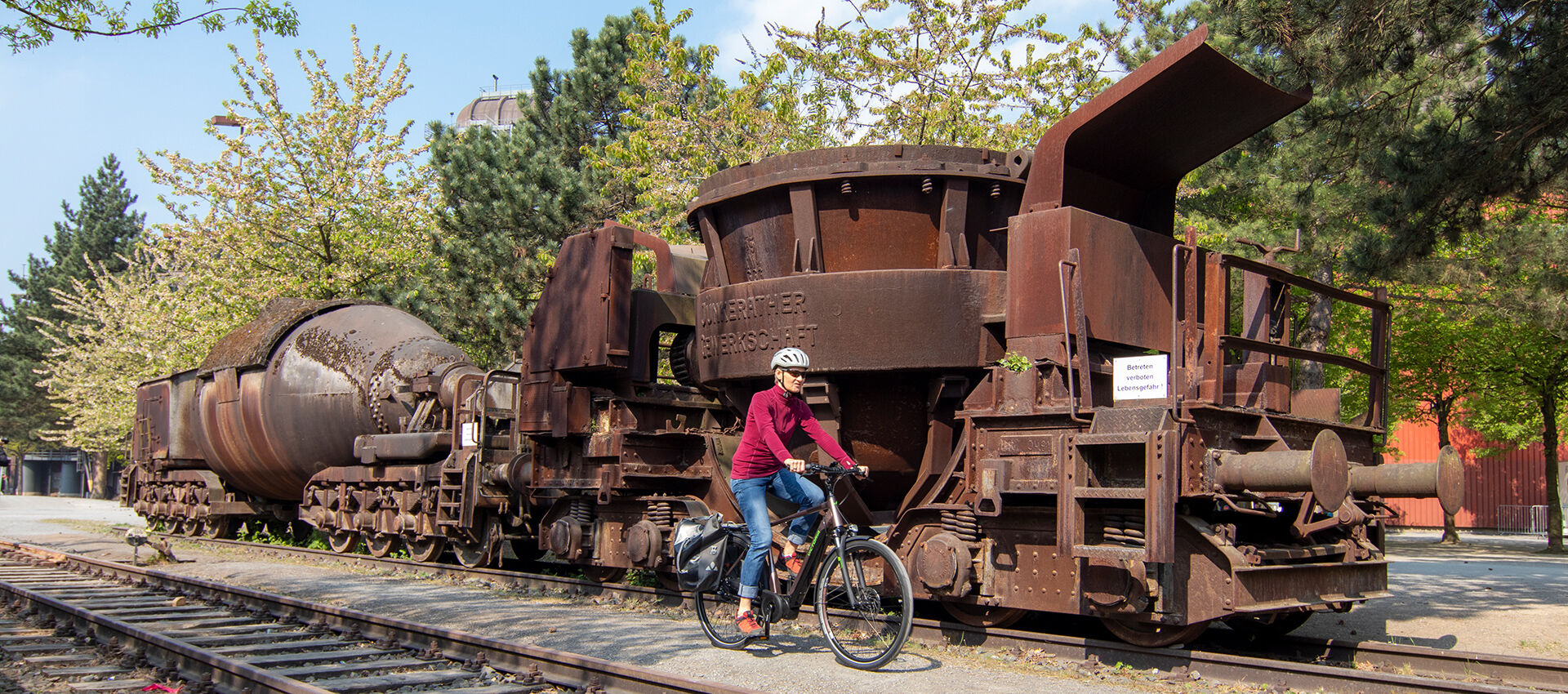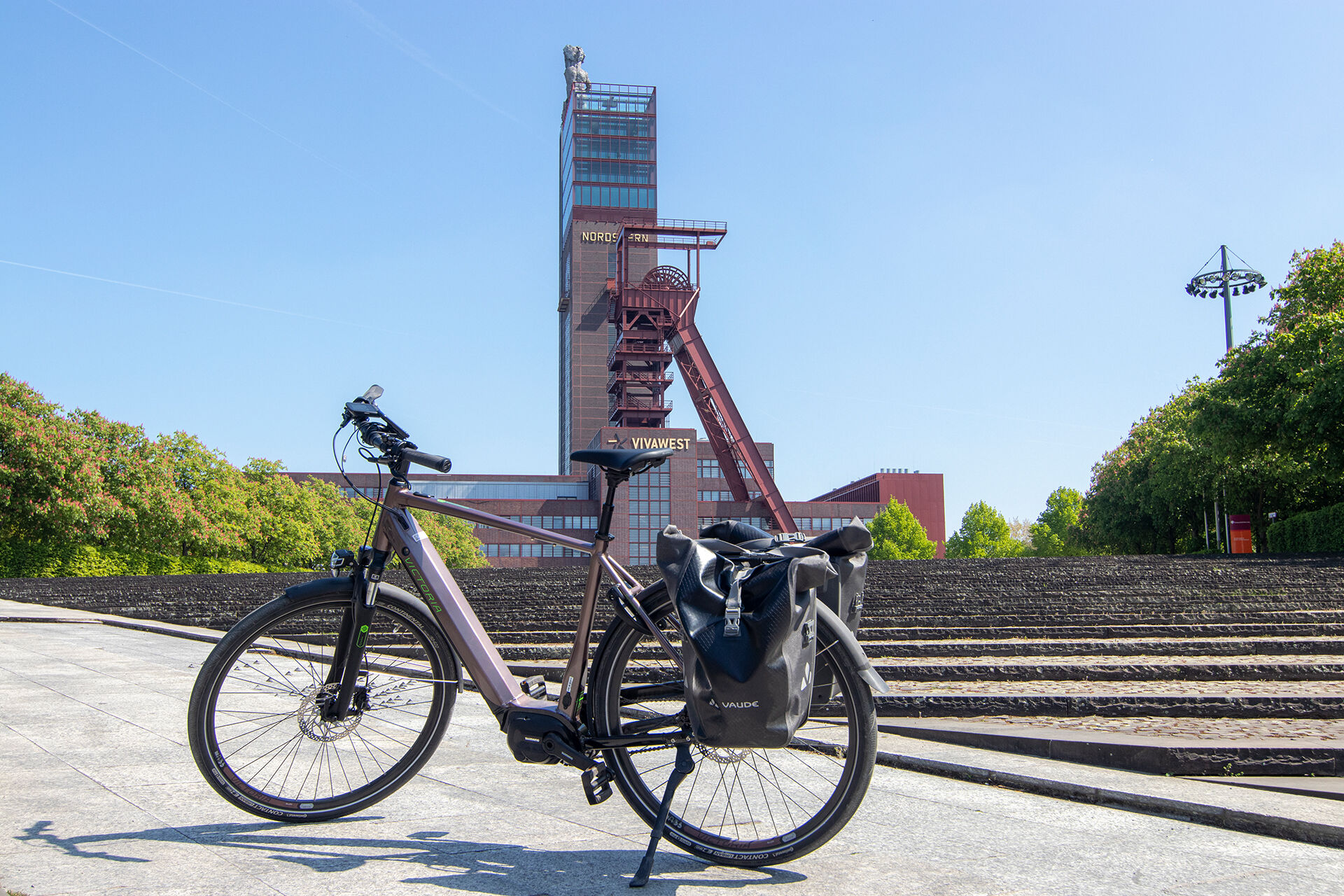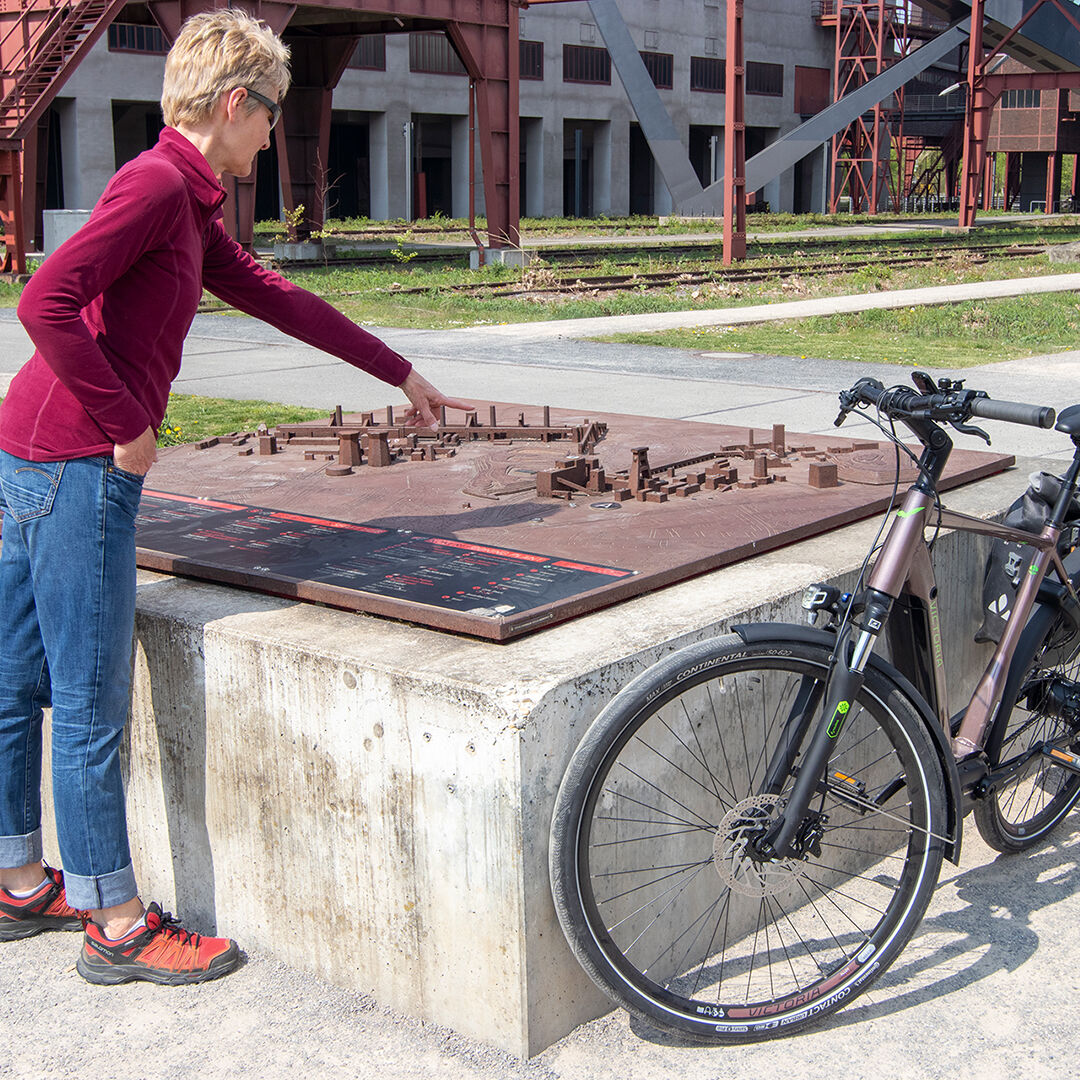The route of industrial culture in the German Ruhr region: From Duisburg to Essen
You might be asking: is the Ruhr area actually a place to enjoy riding your bike? Absolutely! The “Ruhrpott" is anything but dreary and grey. In fact, although some cities merge directly into each other, you can ride along former railway lines or rivers such as the Ruhr and the Emscher,. These offer long straights that are completely flat or with a low gradient. They are also very green and mostly free of cars.
Basic information on the Route of industrial culture between Duisburg and Essen
If you want to get an overview of the former industrial heart of Germany - and how much nature and culture has grown out of it - you should also climb the two heaps on our route. Architectural delights can be seen from afar and are often reminiscent of the industrial past. It’s a real reward, whilst standing on one of these artificial hills made by the mines. Two in particular have caught our eye, and the tour starts with the first heap.
Also, the routes in this region are very well signposted. You can also get along nicely without GPS data. Nevertheless, it makes sense to select your desired destinations beforehand. The websites route-industriekultur.ruhr or ruhr-tourismus.de can help you find your desired route. Here, maps can also be downloaded or ordered. We have put together a tour with the most sights for you to enjoy.
The start: Duisburg, Ehringerstrasse.
If you come by car, you will find a parking spot right at the foot of the heap. Train riders take the number 903 from the main station to the Tiger & Turtle stop - on weekdays you can take a bike with you from 9 a.m., on weekends all day.
It starts with a ride around a hill for about a kilometre towards a playfully arranged steel sculpture, which in fact is a walkable roller coaster. Don't worry: there is no need to climb through the loop in the middle. Nevertheless, the "ride" is a lot of fun. Gravity and logic are being turned on its head - at least that's what the planners had in mind when they came up with the tiger and turtle in 2010.
In fair weather, the view from 20 meters above the heap is magnificent. To the south, you can even see Düsseldorf. When its illuminated at night, this work of art is also worth a visit.




The route leads from the exciting roller coaster to Duisburg's inner harbour, in the south of the city. It isn’t part of the industrial culture cycle routes and can sometimes have a lot of traffic. But you get to see a lot of classic architecture: Old houses of the industrial workers can be seen, and you feel like you've been transported back to the "old" Ruhr area.
Duisburg's inner harbour - between industry and art
Duisburg's inner harbour is an imposing industrial monument. A fascinating area that shows how industry can become culture and art. Once a large industrial port, it has become a synthesis of life, leisure, living, working and culture. And the monument itself is an architectural work of art, that proves how well everything fits together. The best way to discover this place is to take a tour. If you don’t have the time, simply take a shortcut over one of the bridges and circle the northern parts of the inner harbour. It is teeming with impressive architectural photo spots. A little more hidden is the huge wall facing east of the Küppersmühle extension. The well-known art museum and its new building, which is open since 2021, are worth a visit - not only because of the exhibitions on modern art, but also because of the architecture.
During the next part of the route, we experience what "port" still means today, as we reach the Duisburg-Ruhrort ports. This area is the largest inland port in Europe and sits at the confluence of the Rhine and Ruhr. It's worth stopping on the Karl-Lehr-Bridge and taking a look around.
We cross the railway port and ride past the interactive Museum of German Inland Shipping on the Deichstrasse. We continue along the Rhine, where you can let your eyes wander into the distance. On the horizon you can see the old railway bridge, which is another sight to behold.
Landscape Park Duisburg-Nord - one of the prettiest city parks of the world
After a short break on one of the benches with a view of the Rhine, we head towards the Landscape Park Duisburg-Nord, called “Lapano” by the locals. It’s the green lung, as well as local recreation area, leisure center, adventure playground and meeting place all wrapped into one. The former iron works are one of the most beautiful city parks in the world. We recommend riding your bike through the areas and let your imagination run wild! In addition to the walk-in blast furnace - which is 55 meters high and reachable through steel steps - it has so called climbing "mountains" in the ore bunker, a high-altitude climbing course in the blast furnace, a diving pool in the gasometer and an open-air cinema. But above all else, there are many beautiful corners for barbecuing with family or friends. The park is well attended on weekends in spring and summer. And for anyone who is interested in industrial history and technology, they can find guided tours in the information center.



Green path and Rhine-Herne Canal
The beautiful green path leads us directly through the Landscape Park Duisburg-Nord, which takes us through the countryside without any traffic, even though we are in one of the most densely populated areas in Germany. Then we follow the Emscher. These well-maintained paths, mostly paved with gravel, are typical for the route.
Finally, we continue next to the Rhein-Herne Canal. Here we discover, how creativity has been turned into architecture: The Slinky Springs to Fame, a pedestrian and bicycle bridge that appears to consist of a spiral spring that casually hangs over the canal, immediately catches the eye. Walking over it is an experience – especially for photographers. And in summer there is a lot going on here, on both banks of the Rhine-Herne Canal.
Garden lovers can also take a look at the Kaisergarten. Right next to it you will find a small animal zoo to explore.
If you don't want to go to the current exhibition in the huge Gasometer Oberhausen, you can head to the other side of the canal to discover the second heap: The Bottrop Beckstraße. This 90 meter high structure is easy to climb with an e-bike through the eight serpentines. Should you prefer the quieter route, there are paths around it, which will also get you to your destination. Perhaps the best-known landmark can be seen on the plateau: the tetrahedron. It mimics the silhouette of a three-legged pyramid with three ring-shaped observation decks, with the top being a whopping 38 meters high. This steel structure does look quite majestic. Not all visitors actually dare to ascent it. But it's worth it after all, since you are high above the surrounding area and with great views all around. Then it's back to the Emscher, first to the left of it, then to the right, where we meet the Rhine-Herne Canal again.






Fries and a break at the Nordstern Park
We continue straight to make a welcome detour to Nordstern Park. The grounds of the State Horticultural Show in 1997 have since become synonymous as the place to be around Gelsenkirchen. In the large beer garden, which sits opposite the old colliery building, various different versions of the local fries can be enjoyed. This is where you will encounter people from the Ruhr region, especially on weekdays. They mostly go out to the countryside for a bit, or they work in one of the new buildings in the area.






There are many simple alternatives for the return trip, since the train station Zollverein Nord is not far from the winding tower (attention e-bikers: there is no elevator!). We got onto the regional train 32 to Duisburg main station. From there, a tram line leads directly to the Tiger and Turtle stop. It has been a nice journey - we highly recommend it!





What bike did we ride?
Equipped with Shimano‘s "Steps E6100" motor for stable power, a 504 Wh battery, hydraulic disc brakes and electronic Shimano "Nexus 5" Di2 shifting, our touring pedelec ticks all the boxes. Wether off road or on tarmac - there is plenty of comfort that makes the eTouring 11.7 the perfect match for your next bike ride or trekking tour.
The Zeche Zollverein
On the last stop on our route, we cross the Emscher and the Rhine-Herne Canal once more. We will get to enjoy one of the most beautiful inventions since the industrial past has vanished: turning industrial roads and railway tracks into fascinatingly beautiful cycle paths and connecting the whole thing with a winding forest path. A great way to use the already existing infrastructure! After about seven kilometres we reach what is probably the best-known industrial monument in Europe: the Zeche Zollverein with its mighty, 55-metre-high winding tower. The symbol of the Ruhr area and the city of Essen.
The UNESCO World Heritage Site has more to offer than “just” its title. Guided tours and art exhibitions can be visited in the museum and main building - after you cleared the famous and endlessly long escalators, of course! But the colliery is also known for its music and events. And amidst the boilers, pumps, conveyor belts and pipes, there's a "works pool", which is great for hanging out and splashing about in summer. And along the coke ovens and their chimneys, there is a 150-meter-long ice rink in winter. However, the whole area is a great place for creative people. Photographers and videographers, artists and musicians will find bizarre, harmonious or even strange backgrounds in the ambience of this park. In any case, you can't help but be amazed. The colliery has a very unique atmosphere. And to top it all off, the cultural and leisure activities as well as exciting education you experience here are really incredible.
Mehr Beiträge im VICTORIA Magazin

E-bike adventure: cycle tour to Sector F in the Bavarian Forest



The Best of both Outdoor Worlds: E-Biking and Hiking in Chiemgau



Enjoying Switzerland - a cycle tour through the “RhineWelten”







